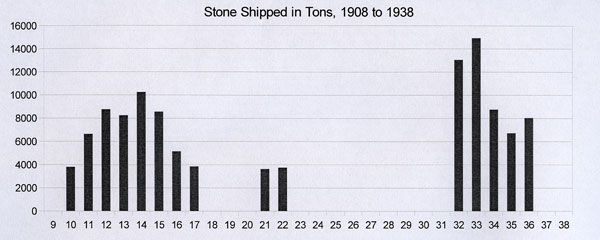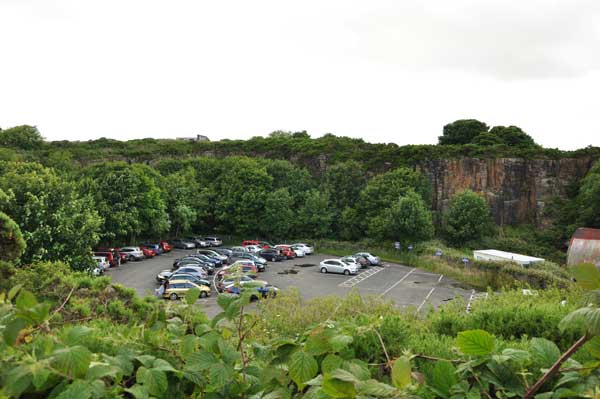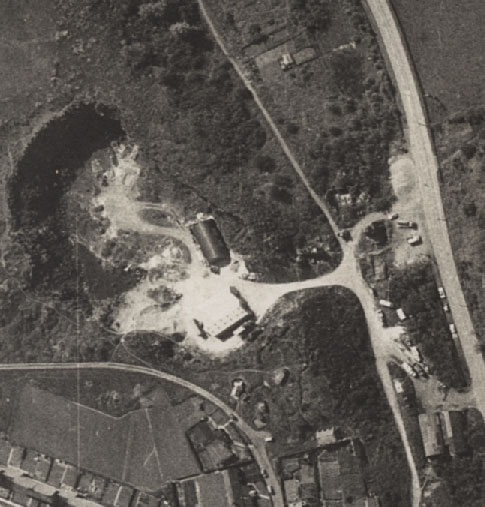 |
|
Archway - Tower Bank |
Quarry, Aerial Ropeway and BinsWhen talking about 'Craster quarry', the large excavation that is now Craster's car park comes to mind. This was operated by McLaren and Prowde and for the last few years of its life by Crowe Catchpole. However, this was not Craster's only quarry. On the opposite side of the road from the car park, on Norwell Brow, lie the remains of another quarry that in the first half of the 20th century was leased by Mark Appleby, the owner of Embleton quarry.
|
|
Quarrying is an old industry at Craster. The following advertisement appeared in the Newcastle Courant on 14th March, 1772. (quoted in the History of Northumberland, volume 2, Ed. Bateson):
'Craster whinstone quarries. Wanted immediately a number of good hands that understand the dressing of the said stones for paving London streets. Apply to Mr. Dan Craster at Preston,'
An article in 'The Times' on March 20th, 1913, outlined the plans for the construction of an aerial ropeway to carry stone from Craster quarry to the harbour.
"The new loading plant will consist of an aerial ropeway to transport the road stone from the quarries to the south pier-head, the point at which the water is deepened, and here it will be dropped into storage bins of about 1,000 tons capacity."
Read the full article The Times 20 03 1913
Memories of the quarry, ropeway and bins by residents of Craster, including those who worked in the quarry, can be found in We Can Mind the Time, an oral history of Craster.
The following is an extract from an account given by Geoff Forster of working at Craster quarry in 1935:
"All of the heavy machinery on site was driven by belts which radiated from two engines in a building located close to the entrance to the quarry. Some remains of the old engine house are still standing next to the Tourist Information Centre (TIC). Frank Watson, who was killed during WW2, worked in the engine house up to the time of the quarry’s closure.
The crusher was on top of the hill above the engine house. This machine crushed the whinstone to make road stone, which was transported by conveyor belt to a cylindrical screen, which graded it into different sizes, ranging from ¼inch to 1½inch, to be stored in a range of bunkers. These bunkers were located on top of the wall to the seaward side of the entrance to the car park. The bunkers were organised so the smaller chippings were stored at the engine house end of the row and the larger at the seaward end. Each bunker had a shute down to the level of the small car park at the side of the main road.
The aerial ropeway came down to earth more or less in the entrance to that small roadside car park, turning around a large wheel to begin its journey back to the bins. The quarry end of the ropeway was worked by two men; one to take the empty buckets on the return journey from the bins off the ropeway and fill them from the shute serving the correct sized chippings for the load being transported. The same man then pushed the newly filled bucket around the system to the second man whose job it was to re-connect the bucket, correctly spaced out from the last bucket, back onto the aerial ropeway. The buckets had a fitting at the top, which clamped tight when the bucket was put onto the ropeway. This latter was Geoff’s job.
He was also responsible for activating or stopping the ropeway. Like all the other machines, the wheel was driven by a belt from the engine house that crossed the quarry road. The ropeway was ‘switched on’ by connecting the belt to the drive wheel and ‘switched off’ by disengaging the belt.
The seaward end of the ropeway, on top of the bins, was also manned by two men; one to tip the buckets into the bins and the other to send the empty buckets back on their way to the quarry. If they, for any reason, wanted the ropeway stopped, they signalled to the quarry end by means of a flag and Geoff stopped the system."
The full version of Geoff's account can be read by following this link.
The quarry was sold to a London firm, Crowe and Catchpole, in 1936. Shortly afterwards the silos were demolished; they were redundant, judged to be unsafe and according to local belief, condemned as a landmark for enemy navigation at the beginning of the war.
Taken on May 17th 1964, the following photograph shows the quarry long after it ceased production, but before its conversion into a car park. Notice the gardens at the top of the photo that were later transformed into the Arnold Memorial Nature Reserve.
|
The harbour account book, with annual accounts from 1908 to 1938, is an invaluable source of information about the activity in the harbour. Extracts from this book have been transcribed and can be downloaded from here.
The spreadsheet was written in Open Office, which can be downloaded free of charge from Open Office.
The following chart shows the quantity of stone shipped from the harbour during this time. The accounts suggest that export of stone by sea took place during the period 1910 to 1917, rising to a peak in 1914 and tailing off during the war. Activity appears to have resumed briefly in 1921/22 and then the business took off again in the 1930's. Shipments totalled 114,030 tons. (Note; the Total in 1933 is lower than it should be as precise figures were only given for the first half of the year.) The account book has nothing to say of course about the stone that was transported by road.
 |
In the 1911 census, John Rowland McLaren, 'public works contractor and whinstone quarry owner', is recorded as being resident at North Craster with his wife Hilda Mary, children Gwendoline (5) and Roland (3) and uncle, John McLaren (78).
 |
Home Programme Membership Archive War Memorials History Walk Miscellanea Links Contact Us

